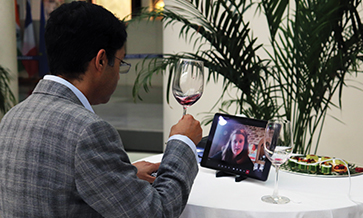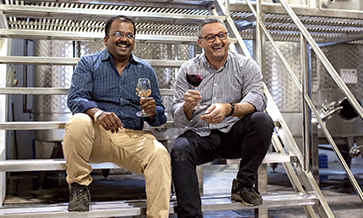The President of the All-India Wine Producers’ Association, Yatin Patil, also heads the Nashik-based Vintage Wines with its award-winning Reveilo label. He spoke to Rohit Arora and Roy Thomas about the role of AIWPA, rising domestic wine standards and ‘low-alcohol’ wines. Excerpts:
How challenging is it for you to juggle between the roles of Director of Reveilo Wines and head of AIWPA?
Both the roles need attention as both are fairly small organisations and operate on a peer-to-peer basis. While AIWPA’s internal meetings can be scheduled according to one’s convenience and availability, where meetings with the government are concerned, there is no fixed time for it. It has been challenging at times; but one chooses to look at the bigger picture and prioritise tasks.
When was the AIWPA established?
The association was formally established in October 1996 under the Societies Registration Act of 1860. AIWPA is also registered under the Bombay Public Trust Act, 1950, and has been filing annual returns with the charity commissioner in Mumbai.
Who are the members of your association? How many wineries are registered with it?
Predominantly, it is the Indian wineries who are members of the association. They can do so by paying a registration fee. Presently, there are 40-45 operational wineries, of which 18 are active members.
What are the membership criteria and the fee?
One-time registration fee for wine producers (BRL license holder) is Rs. 1,000, along with a yearly membership fee @10 paise per litre capacity. The entry fee for an India supplier/ service provider is Rs. 50,000. For an overseas supplier/ service provider the entry fee is US$ 1,000.
What are the objectives of the AIWPA?
Our long-term objectives are:
- To represent all wine producers in India and uphold their business interests
- To raise funds and carry out research in the field of wine production, horticulture, viticulture and cultivation of grapes
- To represent the issues of wineries to the respective authorities in Central and state governments.
Excise and taxation are holding back the growth of the domestic wine sector. What are the other factors dampening the growth of the industry?
Some of the issues plaguing the Indian wine industry are:
- Restrictions on inter-state movement of produce
- High cost of label registration
- Multi-layer and complicated tax structure
- Incentives doled out to imported wines
- Difference in distribution systems across states.
What have been some significant accomplishments of AIWPA?
We have managed to lift excise duty on blending of wines. We have assisted the FSSAI (Food Safety and Standards Authority of India) in the formulation of wine standards and labelling requirements. We have also sought extension of permission to use old labels.
We are in the process of streamlining the wine industry promotion scheme, under which funds disbursal has exceeded Rs 100 crore in the past 3 years. Negotiations on several free trade agreements are in various stages of progress.
We have started an umbrella initiative with wine producers, called ‘Wines of India’, to promote their marketing; initiated more measures to boost wine tourism; and stepped up India’s participation at international trade fairs through APEDA (Agricultural and Processed Food Products Export Development Authority).
In Karnataka, we have taken the initiative to streamline the licensing process by delegating permissions to district level; and have managed to merge licenses (manufacturing and bottling) into one.
Other ancillary issues – such as storage of unlabelled finished bottles, permission for technical tastings, and temperature control of KSBCL depots – have also been sorted.
What is your advice for existing and upcoming wine entrepreneurs in India?
There are many who are enamoured by the wine business in general. The glamour that people perceive is just that – a perception! My advice is to do proper research on the industry before venturing into it. In India alcohol is a state subject; so the rules of the game change with every state, which can be very difficult at the ground level.
The costs involved – for land, equipment, licensing, registration, sales and distribution, marketing – can be overwhelming and need to be carefully considered while pricing the products. As the raw material is seasonal the working capital cycle too is quite long; so a lot of investment gets sucked into the system.
On the sales front, the biggest challenge is that people drink labels, which implies that it is important to build the brand, which needs a lot of resources in terms of time, energy and money.
Being a prohibited product, mass marketing/ advertising is not permitted, and direct marketing is very costly, especially with a low base and no presence of economies of scale. As the saying goes, “If you want to make a million in the wine business, start with 10 million.”
Do you see wine tourism as the next big thing in the Indian wine industry?
Wine tourism is definitely on the rise. Nashik is touted as India’s ‘Napa Valley’. There is a lot of curiosity among people to visit various wineries or head out on a wine trail. This is due to the increased awareness levels and a well-travelled consumer. Sula had about 2,00,000 visitors at its Nashik facility last year.
Is the Indian hospitality industry supportive enough of Indian wine producers?
Indian wines deserve more space on restaurant menus. Currently you see only two or three Indian wines on the menu vis-à-vis a handful of the imported wines. Part of it is due to the perception that imported wines are better. Many Indian wines have come of age and offer far more value than imported wines. We need to communicate this to consumers.
We also have a programme called ‘Wines of India’, an umbrella marketing of Indian wines by the industry. AIWPA has been insisting on quality standards for some time. Effective April this year, the FSSAI has introduced benchmarks for the alcoholic beverage industry which, with effective enforcement, will definitely improve overall standard of Indian wines.
There is global trend of consumers switching to low-alcohol wines. What do you think?
Yes, the trend is shifting towards low-alcohol wines, especially with the younger generation, which is new to wines. It also makes the beverage more fun and less intimidating. Once they are ready, they can move to regular wines.
Technically there is no challenge associated with making low-alcohol wines in India. Such wines are basically “wine-based beverages” and feature under a separate category. They should not be clubbed and confused with wines. The AIWPA has already intimated the FSSAI to add and frame rules for the wine-based beverages.













